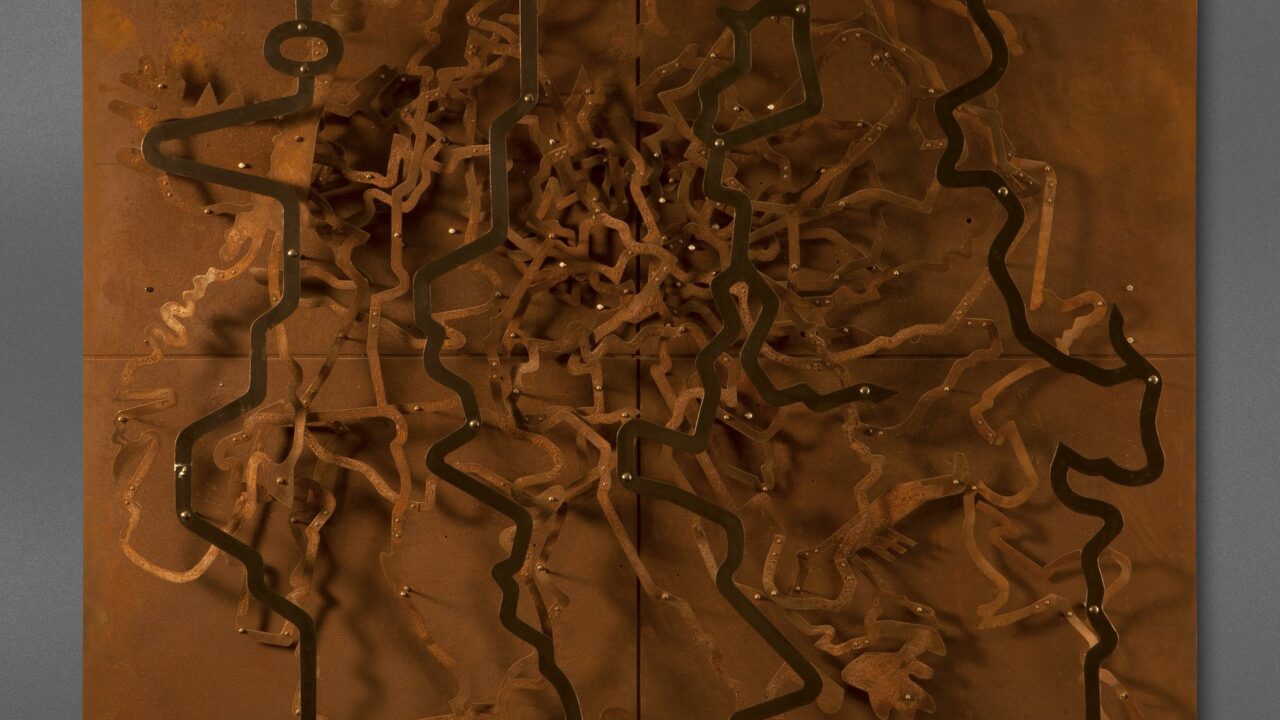1. European Union. The project of European construction. Democracy and its rules of the game
We begin this artistic journey around democracy with a set of works that materialize positive and exciting visions about the realization of the European project.
Artworks

Françoise SCHEIN: Ideoglyphe Européen, 1988 – On display at the Parlamentarium, Brussels

John VASSAR HOUSE: Parlamento Europeo, 1979 – On display at the Parlamentarium, Brussels

John Goudie LYNCH: Hémicycle Strasbourg, 1987 – On display at the Parlamentarium, Brussels

Olivier STREBELLE: Confluences, 1992 – On display at the Visitors’ area, Brussels




At the end of the 1980s, Françoise Schein produced a series of panels comparable to reliefs, the formal references of which can be found in the urban development plans of large modern cities or in maps of infrastructure and communication rotes (metro and train lines, major roads, airways). Her Ideoglyphe Européen (1988) consists of a labyrinthine pattern of criss-crossing routes and directions, superimposed on a metal surface that has been deliberately rusted; a network of winding roads among which twinkle tiny electric bulbs positioned where the EU’s capitals would be on a map of the continent. The ensemble is crowned by a row of small clocks indicating the time zones, which, according to Schein’s intention, should all be properly set as a sign of understanding and agreement among the countries: “mettre des montres à l’heure = signe de l’entente, accord”.
In 1997, when the artwork was acquired and presented in the European Parliament, Schein defined this panel-relief as an “abstract work that deals in fact with the theme of European construction. Describing the borders of a continent in motion and in full swing, this work was conceived two years before the fall of the Berlin Wall. Premonitory of an event that would shake Europe after the Second World War, I made this sculpture after having lived in New York for ten years, a long period of absence and estrangement that undoubtedly allowed me to understand, thanks to that regard from the outside, the cohesion that exists among all the countries of Europe, cohesion created by a single people: the Europeans”
Schein also defined the Ideoglyphe as the first in a long series of large-format works that she had undertaken since 1989. Her international urban art project, developed in various metro stations in European capitals, also adopted a fundamental motive: the network, with the aim of expressing the close relationship between knowledge and democracy.
Another emblematic object that deals with the key function of the European Parliament as the engine of parliamentary democracy on the continent, is European Parliament (1979). Its author, John Vassar House, designed an object reminiscent of a large compass, astrolabe or scientific navigation instrument, that symbolically represents a specific moment in the history of the European project, in 1979:
“The European Parliament piece commemorates the elections of 1979 and represents a moment when several European countries are about to join membership. The existing countries are part of the ring with their distinctive wedge shape to form a solid circle. New members are ready to join in as part of a centrifugal force”.
In addition, the morphology of the sculpture incorporated a significant reference to the division of powers within the European Community:“The small laminated ring which revolves about its axis of 3 pins – which stand for the council, commission and judiciary – represents the mechanism of non legislative functions”.
These inspiring principles were translated into a fascinating rotating mechanism, an imaginary compass or watch which, set at a dynamic inclination on its axis, marks the movements of an action coordinated between the countries that made up the European Union in 1979 and those that were waiting to join shortly.
Having designed this sculpture as a “visual commemoration of the immensely historical moment when the first universal suffrage takes place for the European Parliament”, Vassar provided further clues about its meaning: “The wedge-shaped elements of the ring are the 9 member countries, each sized according to its voting strength. Their external surfaces express the individuality of the countries, while the inner surface of the ring represents their fusion into a single unit: the European Parliament. Three counter-clockwise movements on the inner ring respectively back France – Germany, Benelux – Italy and Denmark – Great Britain – Ireland as a chronology of recent European cooperation. Greece is poised waiting to enter the circle. The base, symbolizing the electorate, is composed of a flow of various political currents upon which the entire Parliamentary structure rests. These currents crest as a kinetic force, giving impetus to the Parliament’s activities”.
The chamber where the legislative power of the European Community resided was represented in Hémicycle Strasbourg (1987), which shows an aspect of the hemicycle in full session chaired by P. Daenkert in 1987, probably taken from a photograph of the period and pictorially interpreted by John Goudie Lynch with documentary accuracy and technical neatness.
Near the other great hemicycle of the European Parliament, in Brussels, stands the monumental Confluences (1989),by the Belgian sculptor Olivier Strebelle, defying gravity as one of his technically most daring works. The artist erected a veritable steel tree, a strong cylindrical trunk that rises and branches out in a great number of tubes grouped in bunches that meet, spread out and sway in the Spaak Building’s atrium. A free and organic structure that symbolises, as its title suggests, a sphere of confluences and meetings, of fraternity and good understanding that the European nations must seek to maintain in their exchanges and common enterprises.
Read less